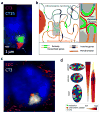The Molecular Revolution in Cutaneous Biology: Chromosomal Territories, Higher-Order Chromatin Remodeling, and the Control of Gene Expression in Keratinocytes
- PMID: 28411854
- PMCID: PMC5567742
- DOI: 10.1016/j.jid.2016.04.040
The Molecular Revolution in Cutaneous Biology: Chromosomal Territories, Higher-Order Chromatin Remodeling, and the Control of Gene Expression in Keratinocytes
Abstract
Three-dimensional organization of transcription in the nucleus and mechanisms controlling the global chromatin folding, including spatial interactions between the genes, noncoding genome elements, and epigenetic and transcription machinery, are essential for establishing lineage-specific gene expression programs during cell differentiation. Spatial chromatin interactions in the nucleus involving gene promoters and distal regulatory elements are currently considered major forces that drive cell differentiation and genome evolution in general, and such interactions are substantially reorganized during many pathological conditions. During terminal differentiation of the epidermal keratinocytes, the nucleus undergoes programmed transformation from highly active status, associated with execution of the genetic program of epidermal barrier formation, to a fully inactive condition and finally becomes a part of the keratinized cells of the cornified epidermal layer. This transition is accompanied by marked remodeling of the three-dimensional nuclear organization and microanatomy, including changes in the spatial arrangement of lineage-specific genes, nuclear bodies, and heterochromatin. This mini-review highlights the important landmarks in the accumulation of our current knowledge on three-dimensional organization of the nucleus, spatial arrangement of the genes, and their distal regulatory elements, and it provides an update on the mechanisms that control higher-order chromatin remodeling in the context of epidermal keratinocyte differentiation in the skin.
Copyright © 2016 The Author. Published by Elsevier Inc. All rights reserved.
Figures

References
-
- Adoue V, Chavanas S, Coudane F, Mechin MC, Caubet C, Ying S, et al. Long-range enhancer differentially regulated by c-Jun and JunD controls peptidylarginine deiminase-3 gene in keratinocytes. J Mol Biol. 2008;384:1048–57. - PubMed
-
- Bickmore WA. The spatial organization of the human genome. Annu Rev Genomics Hum Genet. 2013;14:67–84. - PubMed
-
- Brianna Caddle L, Grant JL, Szatkiewicz J, van Hase J, Shirley BJ, Bewersdorf J, et al. Chromosome neighborhood composition determines translocation outcomes after exposure to high-dose radiation in primary cells. Chromosome Res. 2007;15:1061–73. - PubMed
Publication types
MeSH terms
Substances
Grants and funding
LinkOut - more resources
Full Text Sources
Other Literature Sources

